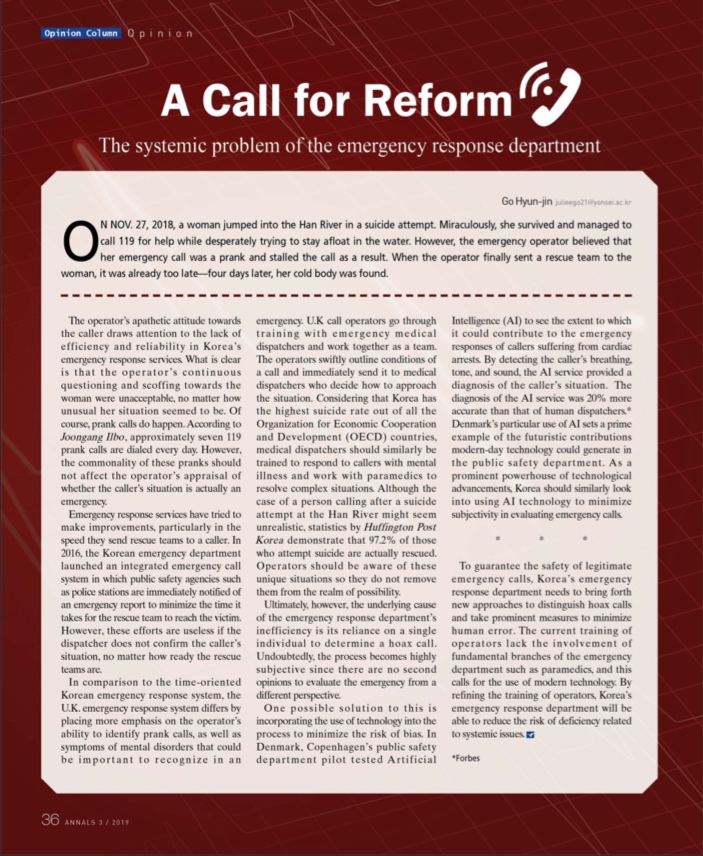The systemic problem of the emergency response department

ON NOV. 27, 2018, a woman jumped into the Han River in a suicide attempt. Miraculously, she survived and managed to call 119 for help while desperately trying to stay afloat in the water. However, the emergency operator believed that her emergency call was a prank and stalled the call as a result. When the operator finally sent a rescue team to the woman, it was already too late––four days later, her cold body was found.
The operator’s apathetic attitude towards the caller draws attention to the lack of efficiency and reliability in Korea’s emergency response services. What is clear is that the operator’s continuous questioning and scoffing towards the woman were unacceptable, no matter how unusual her situation seemed to be. Of course, prank calls do happen. According to Joongang Ilbo, approximately seven 119 prank calls are dialed every day. However, the commonality of these pranks should not affect the operator’s appraisal of whether the caller’s situation is actually an emergency.
Emergency response services have tried to make improvements, particularly in the speed they send rescue teams to a caller. In 2016, the Korean emergency department launched an integrated emergency call system in which public safety agencies such as police stations are immediately notified of an emergency report to minimize the time it takes for the rescue team to reach the victim. However, these efforts are useless if the dispatcher does not confirm the caller’s situation, no matter how ready the rescue teams are.
In comparison to the time-oriented Korean emergency response system, the U.K. emergency response system differs by placing more emphasis on the operator’s ability to identify prank calls, as well as symptoms of mental disorders that could be important to recognize in an emergency. U.K call operators go through training with emergency medical dispatchers and work together as a team. The operators swiftly outline conditions of a call and immediately send it to medical dispatchers who decide how to approach the situation. Considering that Korea has the highest suicide rate out of all the Organization for Economic Cooperation and Development (OECD) countries, medical dispatchers should similarly be trained to respond to callers with mental illness and work with paramedics to resolve complex situations. Although the case of a person calling after a suicide attempt at the Han River might seem unrealistic, statistics by Huffington Post Korea demonstrate that 97.2% of those who attempt suicide are actually rescued. Operators should be aware of these unique situations so they do not remove them from the realm of possibility.
Ultimately, however, the underlying cause of the emergency response department’s inefficiency is its reliance on a single individual to determine a hoax call. Undoubtedly, the process becomes highly subjective since there are no second opinions to evaluate the emergency from a different perspective.
One possible solution to this is incorporating the use of technology into the process to minimize the risk of bias. In Denmark, Copenhagen’s public safety department pilot tested Artificial Intelligence (AI) to see the extent to which it could contribute to the emergency responses of callers suffering from cardiac arrests. By detecting the caller’s breathing, tone, and sound, the AI service provided a diagnosis of the caller’s situation. The diagnosis of the AI service was 20% more accurate than that of human dispatchers.* Denmark’s particular use of AI sets a prime example of the futuristic contributions modern-day technology could generate in the public safety department. As a prominent powerhouse of technological advancements, Korea should similarly look into using AI technology to minimize subjectivity in evaluating emergency calls.
* * *
To guarantee the safety of legitimate emergency calls, Korea’s emergency response department needs to bring forth new approaches to distinguish hoax calls and take prominent measures to minimize human error. The current training of operators lack the involvement of fundamental branches of the emergency department such as paramedics, and this calls for the use of modern technology. By refining the training of operators, Korea’s emergency response department will be able to reduce the risk of deficiency related to systemic issues.
*Forbes
Go Hyun-jin
julieego21@yonsei.ac.kr

